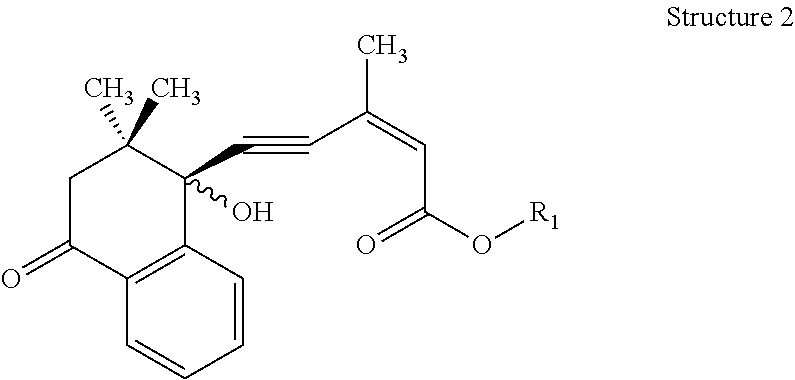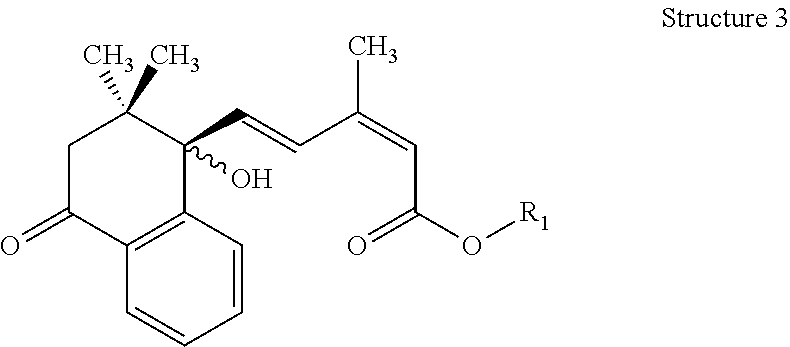Novel Plant Growth Regulator Compositions, Methods of Preparation and Use Thereof
a technology of plant growth regulator and composition, which is applied in the field of plant growth regulator composition, can solve the problems of increasing the cost of container disposal, increasing the cost of transportation, warehousing, and increasing the solubility of abscisic acid in water, and achieves the effect of high efficiency and cost-effectiveness
- Summary
- Abstract
- Description
- Claims
- Application Information
AI Technical Summary
Benefits of technology
Problems solved by technology
Method used
Image
Examples
example 1
[0115]Compositions of 40% wt / wt S-(+)-Abscisic Acid Aqueous Dolution Formulation for Seed Treatment (Table 2)
[0116]The potassium sorbate was solubilized in water followed by simultaneous addition of S-(+)-Abscisic acid and potassium hydroxide maintaining a pH <9.00 throughout. Upon complete solubilization of S-(+)-Abscisic acid the required amount of sodium sulfite and sodium citrate were added ensuring complete solubilization followed by addition of Tween® 20 and Agrimer® 30 and further mixing for 15 minutes. The final formulation was sieved through 325 mesh to remove any insoluble impurities. The suitability of the formulation composition was studied in corn seed treatment. In the fables that follow, “q.s.” is an abbreviation for “quantity sufficient” which indicates that enough of the composition component was added to bring the composition to the indicated volume.
TABLE 2Composition of 40% wt / wt S-(+)-Abscisic acid AqueousSolution Formulation for Seed Treatment (Example 1)V0397-0...
example 2
Compositions Evaluated in the Development of S-(+)-Abscisic Acid Aqueous Suspension Concentrate (Table 3)
[0118]In Example 2-A, a pre-mix in a portion of water was prepared by solubilizing potassium sorbate, tetrasodium EDTA, propyl gallate solution, Agrimer® 30solution, Tween® 20 and solution of methyl and propyl paraben in propylene glycol. To this, Norlig® A, antifoam 100FG and S-(+)-Abscisic acid were added and mixed. The remaining portion of water was added and wet milled utilizing a Lab-scale Attritor with 2400 g of ⅛ inch stainless steel grinding media. Xanthan gum which was pre-dispersed in a small portion of propylene glycol was added after two hours of wet milling. The milling process was continued for an additional three hours to reduce the particle size. The formulation appeared to be very viscous and not flowable or pourable.
[0119]In Example 2-B, the amount of Norlig® A (calcium lignosulfonate) was increased to 3.0% and the amount of Agrsmer® 30 solution was decreased to...
example 3
[0121]Preparation of 25% wt / wt S-(+)-Abscisic acid Aqueous Suspension Concentrate (Table 4)
[0122]The composition utilized in the development of an experimental aqueous suspension concentrate formulation containing 25% wt / wt S-(+)-Abscisic acid is shown in Table 4. In this example, a pre-mix in water was prepared by solubilizing and dispersing potassium sorbate, tetrasodium EDTA, propyl gal late, Agrimer® VA6, Pluronic® 10R5, Pluronic® P104, Antifoam SAG 1572 emulsion, and a mixture of propylene glycol, methyl paraben, propyl paraben, and xanthan gum followed by slow addition of 25% wt / wt S-(+)-Abscisic acid technical powder under mixing which is continued until a homogeneous mixture is obtained. The pre-mix was then charged to an Attritor containing 1300 grams of ⅛ inch stainless steel grinding media. The contents were milled until the desired particle size is achieved. Additional antifoam was added and mixed. The suspension was collected by sieving through an appropriate sieve. Thi...
PUM
 Login to View More
Login to View More Abstract
Description
Claims
Application Information
 Login to View More
Login to View More - R&D
- Intellectual Property
- Life Sciences
- Materials
- Tech Scout
- Unparalleled Data Quality
- Higher Quality Content
- 60% Fewer Hallucinations
Browse by: Latest US Patents, China's latest patents, Technical Efficacy Thesaurus, Application Domain, Technology Topic, Popular Technical Reports.
© 2025 PatSnap. All rights reserved.Legal|Privacy policy|Modern Slavery Act Transparency Statement|Sitemap|About US| Contact US: help@patsnap.com



